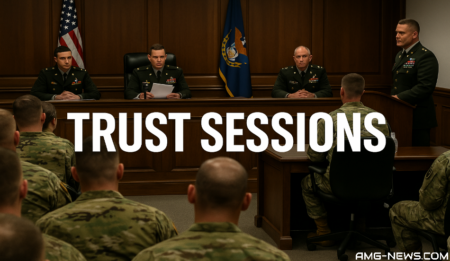JPMorgan Chase CEO Jamie Dimon has Sounded the Alarm Bells: Biggest Banks At Risk Of Collapse This Winter As Massive Failures Begun
Medeea Greere, an independent publisher, is now on Telegram at https://t.me/AMGNEWS2022 and exists only on reader support as we publish Truth, Freedom and Love for public awareness. Thank You for your support!
In a world teetering on the brink of financial catastrophe, the alarm bells are ringing louder than ever. JPMorgan Chase CEO Jamie Dimon, a titan of the banking industry, has issued a chilling warning: “Now may be the most dangerous time the world has seen in decades.” As massive failures begin to shake the foundations of the global financial system, it’s imperative that every American pays heed, for the impending turbulence will touch all of our lives.
The Gathering Storm: Unprecedented Risks and a Wall of Worry
Bank executives are sounding the alarm about unprecedented risks lurking in the shadows of the financial system. Jamie Dimon, the captain of JPMorgan Chase, is leading the charge. He warns that we are on the cusp of a financial cataclysm, as rising interest rates cast an ominous shadow over banks’ stability and solvency. This isn’t just Wall Street hype; it’s a dire reality that could impact every citizen.
Dimon’s sobering proclamation came at the start of the third-quarter earnings season, setting the stage for a tumultuous year-end. He writes in the company’s latest report, “Now may be the most dangerous time the world has seen in decades.” It’s a statement that should send shivers down our collective spines.
In an interview with CNN, Dimon further emphasized that bank executives across the United States are “climbing the wall of worry.” This phrase underscores the grim sentiment prevailing on Wall Street right now, as risk assessments take a sharp downturn.
$650 Billion and Counting: The Bond Market Rout
The specter of unrealized losses now looms large over U.S. banks, with analysts estimating a staggering $650 billion in unrealized losses in their securities portfolios. This ominous figure is a direct consequence of the bond market’s third-quarter rout, driven by the grim prospect of interest rates remaining higher for an extended period.
The consequences of unrealized losses have been brought into sharp focus since the collapse of Silicon Valley Bank in March. The institution’s decision to sell a portfolio of holdings at a substantial loss triggered a chain reaction that led to its downfall. This event has unleashed the most severe industry turmoil since the 2008 financial crisis, and it’s a harbinger of even darker times ahead.
Moody’s Downgrades and the Vulnerable Banking Sector
The woes of the banking industry have escalated with Moody’s Investors Service downgrading the credit ratings of ten small and mid-sized American banks. These actions have ignited a wildfire of concerns, ranging from increased costs and decreased profitability to specific exposures that could be ticking time bombs. The banking sector’s vulnerability to another crisis is now a critical question that demands answers.
Debt Delinquency: A Ticking Time Bomb
Debt delinquency is another ticking time bomb that threatens to explode. Losses have surged to 3.63%, a staggering 1.5 percentage points higher than the lowest point. The outlook is grim, with predictions of losses rising another 1.3 percentage points to 4.93% by the end of 2023. These sobering statistics come at a time when Americans are drowning in more than $1 trillion of credit card debt, a historic high.
The repercussions are already being felt by ordinary Americans, with a 20% increase in personal bankruptcies reported by legal services firm Epiq. While filing for bankruptcy may offer some relief from financial pressure, it comes at a steep cost, impacting credit scores for up to a decade and making it exceedingly difficult to secure housing, loans, jobs, or even security clearances.
Corporate Bankruptcies: The Unfolding Catastrophe
The storm clouds are not limited to personal finances; they are engulfing corporate America as well. Over 400 corporations have succumbed to bankruptcy, marking the fastest rise since 2010 and doubling the levels seen just a year ago.
The hardest-hit sectors are consumer discretionary and industrial, struggling as consumer demand wanes. Historically laden with substantial debt, these sectors are particularly vulnerable in a rising rate environment. In the past year, corporate interest costs have skyrocketed by 22%, leaving companies grappling with higher wages, energy prices, and materials costs. As a result, an increasing number of businesses are facing the harsh reality of cutting costs, restructuring their debt, or facing insolvency.
The Gathering Storm: A Crisis Looms
As we survey the landscape of the American economy, a grim picture emerges. The consumer is breaking under the weight of debt, companies are crumbling, and the financial system itself is unraveling piece by piece. The storm clouds of another disaster seem to be gathering, and make no mistake – every one of us will be affected by it.
As we navigate these treacherous waters, it’s essential to stay informed, be vigilant, and prepare for the worst while hoping for the best. The road ahead is uncertain, and the financial turmoil may be the most dangerous in decades, but together, we can weather the storm.
Breaking the Bank: The Unprecedented Bank Outages Sweeping America – A Winter of Financial Discontent







![THE BIDEN ILLUSION: TRUMP DROPS CLASSIFIED PROOF DEEP STATE USED ACTORS, CLONES, AND HOLOGRAMS TO FAKE A PRESIDENCY [VIDEO]](https://amg-news.com/wp-content/uploads/2025/06/TRUMP-DROPS-CLASSIFIED-PROOF-DEEP-STATE-USED-ACTORS-CLONES-AND-HOLOGRAMS-TO-FAKE-A-PRESIDENCY-450x262.png)




3 Comments
Pingback: BREAKING NEWS: 64 US Bank Branches Announce Shocking Closure in a Single Week JPMorgan, Wells Fargo, and Goldman Sachs Close Hundreds of Branches - No Shit Sherlock News - noshitsherlock.net - NOSS
You are saying the EBS will come this month, November?
none of these grifters know when or even if the ebs will go off…. no one is coming to save you. sorry for the honest truth,